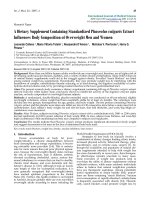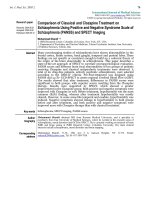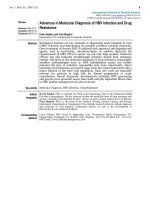Endoscopic balloon dilation of pediatric subglottic and tracheal stenosis
Bạn đang xem bản rút gọn của tài liệu. Xem và tải ngay bản đầy đủ của tài liệu tại đây (3.36 MB, 27 trang )
Respiratory Department 1
Dr Le Thi Thanh Thao
Subglottic & tracheal stenosis:
narrowing of the airway
congenital or acquired (after
endotracheal intubation)
Hoarseness, stridor, exercise
intolerance and respiratory distress
No
SEX
AGE
Diagnosis
GRADE
MANAGEMENT
1
F
1/11/2011
Subglottic acquire
2
Rigit endoscopy 1
2
M
19/6/2010
Subglottic acquire
2
Rigit endoscopy 2
3
M
7/11/2004
Subglottic acquire
2
Rigit endoscopy 2
4
F
17/8/2009
Subglottic acquire
2
Cho Ray
5
F
12/10/2011
Subglottic congenit 2
Observation
6
M
26/12/2010
Subglottic congenit 2
Observation
7
M
24/10/2011
Subglottic acquire
3
FOLLOW UP
death
1 4 dilation procedures / 6 months
Endoscopic high-pressure balloon catheter; general
anesthesia, spontaneous ventilation
Direct laryngoscopy or flexible endoscopy
Balloon: Angioplaty catheter, esophageal, inspira air
Inflated balloon pressure for 30 seconds SPO2 ≤ 92% x
2 - 3 times
The size and diameter of the balloon (Table 1) The
minimum balloon diameter: 6 mm
Videoclip
Topical application of cotonoid pledgets soaked
with mitomycine, 1 mg/mL x 1-2 minutes
Monitoring in the ICU: 24 48 hours
SCS: 1-2 mg/kg/d x 3 to 10 days
Proton pump inhibitors (esomeprazole, 2 mg/kg/d)
Epinephrine nebulizers
Follow-up endoscopy: every 3 weeks until complete
healing, then every 6 months.
ANGIOPLASTY BALLOON
CATHETER
ESOPHAGEAL BALLOON
20 FR FOGARTY BALLOON
CATHER (BAXTER, USA).
NEW BLUE MAX BALLOON CATHETERS (BOSTON
SCIENTIFIC)
Cochrane databases: 1/2013
Inclusion criteria:
1)
Sample size ≥ 5
2)
Use of EBD for pediatric patients (0-18 years)
3)
Use of EBD as the primary treatment of
pediatric subglottic stenosis
Treatment success (%) defined as the
avoidance of more invasive procedures
Recorded complications.
Effect modification by age and the severity of
subglottic stenosis as measured by the CottonMyers grade (I-IV) was also assessed.
7 studies: 150 subjects
Case series (level 4 evidence).
The mean sample size: 20 subjects (5–44)
The grand mean age: 2.2 years (2.2-60 mons)
Follow-up averaged 4.6 months (0.25-12.5)
Treatment success: 65.3% (k= 6 studies, 95%
CI=60.1- 70.6%, p<0.001, Q test,
heterogeneity=3.98, p=0.552, I squared=0%).
One study: atelectasis (3 patients), tracheitis
(2 patients), pneumomediastinum
(asymptomatic, 1 patient), tracheal laceration
(2 patients), death (1 patient, from tracheal
laceration)
Pooled data multivariate regression indicated
increasing Cotton-Meyers grade was associated
with decreased odds of success(OR=0.198, 95%
CI=0.0451- 0.870, p=0.032)
Funnel plot analysis suggested the possibility of
publication bias
Age does not appear to be predictive of
treatment outcomes
Limitations: the heterogeneity of the data.
the included studies were case series.
Nonetheless, EBD is unquestionably simpler
and less invasive than tracheostomy and LTR
to which it might be compared. As a result,
any measurable success of EBD can still be
considered important and useful.
Successful EBD # 2/3 patients / over follow 4
months.
Successful secondary treatment by EBD after
tracheostomy and/or LTR: # 2/3 patients.
Complications: rarely reported but severe
(death by tracheal laceration)
Increasing severity of subglottic stenosis may be
associated with increasing odds of treatment
failure.
Age does not appear to be predictive of
treatment outcomes









